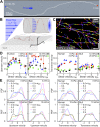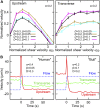Rheotaxis facilitates upstream navigation of mammalian sperm cells
- PMID: 24867640
- PMCID: PMC4031982
- DOI: 10.7554/eLife.02403
Rheotaxis facilitates upstream navigation of mammalian sperm cells
Erratum in
-
Correction: Rheotaxis facilitates upstream navigation of mammalian sperm cells.Elife. 2014 Jun 3;3:e03521. doi: 10.7554/eLife.03521. Elife. 2014. PMID: 24894468 Free PMC article. No abstract available.
Abstract
A major puzzle in biology is how mammalian sperm maintain the correct swimming direction during various phases of the sexual reproduction process. Whilst chemotaxis may dominate near the ovum, it is unclear which cues guide spermatozoa on their long journey towards the egg. Hypothesized mechanisms range from peristaltic pumping to temperature sensing and response to fluid flow variations (rheotaxis), but little is known quantitatively about them. We report the first quantitative study of mammalian sperm rheotaxis, using microfluidic devices to investigate systematically swimming of human and bull sperm over a range of physiologically relevant shear rates and viscosities. Our measurements show that the interplay of fluid shear, steric surface-interactions, and chirality of the flagellar beat leads to stable upstream spiralling motion of sperm cells, thus providing a generic and robust rectification mechanism to support mammalian fertilisation. A minimal mathematical model is presented that accounts quantitatively for the experimental observations.DOI: http://dx.doi.org/10.7554/eLife.02403.001.
Keywords: fertilization; rheotaxis; sperm.
Copyright © 2014, Kantsler et al.
Conflict of interest statement
The authors declare that no competing interests exist.
Figures




References
-
- Adolphi H. 1905. Die Spermatozoen der Säugetiere schwimmen gegen den Strom. Anatomischer Anzeiger 26:549
Publication types
MeSH terms
Grants and funding
LinkOut - more resources
Full Text Sources
Other Literature Sources

